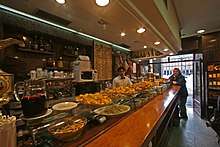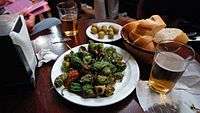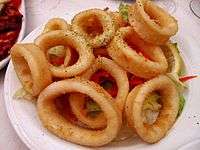Tapas
A tapa (Spanish pronunciation: [ˈtapa]) is an appetizer or snack in Spanish cuisine.
| Course | Appetizer or snack |
|---|---|
| Place of origin | Spain |
| Serving temperature | Hot or cold |
| Main ingredients | Various |
Tapas may be cold (such as mixed olives and cheese) or hot (such as chopitos, which are battered, fried baby squid).
In some bars and restaurants in Spain and across the globe, tapas have evolved into a more sophisticated cuisine. Tapas can be combined to make a full meal. In some Central American countries, such snacks are known as bocas. In parts of Mexico, similar dishes are called botanas.
History

The word "tapas" is derived from the Spanish verb tapar, "to cover", a cognate of the English top.[1]
In pre-19th-century Spain tapas were served by posadas, albergues or bodegas, offering meals and rooms for travellers. Since few innkeepers could write and few travellers read, inns offered their guests a sample of the dishes available, on a "tapa" (the word for pot cover in Spanish).[2]
According to The Joy of Cooking, the original tapas were thin slices of bread or meat which sherry drinkers in Andalusian taverns used to cover their glasses between sips.[3] This was a practical measure meant to prevent fruit flies from hovering over the sweet sherry (see below for more explanations). The meat used to cover the sherry was normally ham or chorizo, which are both very salty and activate thirst. Because of this, bartenders and restaurant owners created a variety of snacks to serve with sherry, thus increasing their alcohol sales.[4] The tapas eventually became as important as the sherry.
Tapas have evolved through Spanish history by incorporating new ingredients and influences. Most of the Iberian Peninsula was invaded by the Romans, who introduced more extensive cultivation of the olive following their invasion of Spain in 212 B.C.[5] and irrigation methods. The discovery of the New World brought the introduction of tomatoes, sweet and chili peppers, maize (corn), and potatoes, which were readily accepted and easily grown in Spain's microclimates.
It has also been claimed that tapas originated in the south of Spain during the time of the Spanish Inquisition as a means of publicly identifying conversos, Jews who had converted to Christianity. Since tapas often consist in part of ham or other non-kosher foodstuffs, the reluctance of the conversos to eat whatever tapas dish was offered to them could be taken as a tacit admission that they had not abandoned their Jewish faith, thus tapas were a tool of the Spanish Inquisition. [6]
There are many tapas competitions throughout Spain, but there is only one National Tapas competition,[7] which is celebrated every year in November. Since 2008, the City of Valladolid and the International School of Culinary Arts[8] have celebrated the International Tapas Competition for Culinary Schools.[9] Various schools from around the world come to Spain annually to compete for the best tapa concept.
Origin
Though the primary meaning of tapa is cover or lid, it has in Spain also become a term for this style of food. The origin of this new meaning is uncertain but there are several theories:
- As mentioned above, a commonly cited explanation is that an item, be it bread or a flat card, etc., would often be placed on top of a drink to protect it from fruit flies; at some point it became a habit to top this "cover" with a snack.
- It is also commonly said that since one would be standing while eating a tapa in traditional Spanish bars, they would need to place their plates on top of their drinks to eat, making it a top.
- Among the Portuguese region of eastern Alentejo, it is claimed that shepherds used to cover jugs of fresh water or wine with bread slices to protect it from snakes while on the field. This bread was finally eaten with chouriço or morcela upon return from herding.
- Others believe the tapas tradition began when king Alfonso X of Castile recovered from an illness by drinking wine with small dishes between meals. After regaining his health, the king ordered that taverns would not be allowed to serve wine to customers unless it was accompanied by a small snack or "tapa".[10]
- Another popular explanation says that King Alfonso XIII stopped by a famous tavern in Cádiz (Andalusian city) where he ordered a cup of wine. The waiter covered the glass with a slice of cured ham before offering it to the king, to protect the wine from the beach sand, as Cádiz is a windy place. The king, after drinking the wine and eating the tapa, ordered another wine "with the cover".[11]
- A final possibility surrounds Felipe III, who passed a law in an effort to curb rowdy drunken behavior, particularly among soldiers and sailors. The law stated that when one purchased a drink, the bartender was to place over the mouth of the mug or goblet a cover or lid containing some small quantity of food as part of the purchase of the beverage, the hope being that the food would slow the effects of the alcohol, and fill the stomach to prevent over-imbibing.
Spain

In Spain,[12] dinner is usually served between 9 and 11 p.m. (sometimes as late as midnight), leaving significant time between work and dinner. Therefore, Spaniards often go "bar hopping" (Spanish: Ir de tapas) and eat tapas in the time between finishing work and having dinner. Since lunch is usually served between 1 and 4 p.m., another common time for tapas is weekend days around noon as a means of socializing before proper lunch at home.
In origin, a tapa was a free portion of food, generally small, served with any drink ordered. In Spain, tapas are traditional in Andalusia, Murcia, León, Extremadura, and Ciudad Real.
It is very common for a bar or a small local restaurant to have eight to 12 different kinds of tapas in warming trays with glass partitions covering the food. They are often very strongly flavored with garlic, chilies or paprika, cumin, salt, pepper, saffron and sometimes in plentiful amounts of olive oil. Often, one or more of the choices is seafood (mariscos), often including anchovies, sardines or mackerel in olive oil, squid or others in a tomato-based sauce, sometimes with the addition of red or green peppers or other seasonings. It is rare to see a tapas selection not include one or more types of olives, such as Manzanilla (olive) or Arbequina olives. One or more types of bread are usually available to eat with any of the sauce-based tapas.
In Andalusia and certain places in Madrid, Castilla-La Mancha, Castile and León, Asturias, and Extremadura, when one goes to a bar and orders a drink, often a tapa will be served with it free. As a drink, it is usual to ask for a caña (small beer), a chato (glass of wine) or a mosto (grape juice). In several cities, entire zones are dedicated to tapas bars, each one serving its own unique dish. In León, one can find the Barrio Húmedo, in Logroño Calle Laurel and in Burgos Calle de la Sombrerería and Calle de San Lorenzo.
Sometimes, especially in northern Spain, they are also called pinchos (pintxos in Basque) in Asturias, in Navarre, in La Rioja (Spain), the Basque Country, Cantabria and in some provinces, such as Salamanca, because many of them have a pincho or toothpick through them. The toothpick is used to keep whatever the snack is made of from falling off the slice of bread and to keep track of the number of tapas the customer has eaten. Differently priced tapas have different shapes or have toothpicks of different sizes. The price of a single tapa ranges from one to two euros. Another name for them is banderillas (diminutive of bandera "flag"), in part because some of them resemble the colorful spears used in bullfighting.
Tapas can be "upgraded" to bigger portions, equivalent to half a dish (media ración) or a whole one (ración). This is generally more economical when tapas are being ordered by more than one person. The portions are usually shared by diners, and a meal made up of raciones resembles a Chinese dim sum, Korean banchan or Middle Eastern mezze.
Common Spanish tapas

- Aceitunas: olives, sometimes with a filling of anchovies or red bell pepper
- Albóndigas: meatballs made of pork and/or beef, served with sauce.
- Allioli: "garlic and oil" the classic ingredients are only garlic, oil and salt, but the most common form of it includes mayonnaise and garlic, served on bread or with boiled or grilled potatoes, fish, meat or vegetables.
- Bacalao: salted cod loin sliced very thinly, usually served with bread and tomatoes
- Banderillas, or pinchos de encurtidos, are cold tapas made from small food items pickled in vinegar and skewered together. They are also known as gildas or piparras and can consist of olives, baby onions, baby cucumbers, or chiles (guindilla) with pieces of pepper and other vegetables, and sometimes an anchovy.[13]
- Boquerones: white anchovies served in vinegar (boquerones en vinagre) or deep fried
- Calamares or rabas: rings of battered squid
- Caracoles
- Carne mechada: slow-cooked, tender beef[14]
- Chopitos: battered and fried tiny squid, also known as puntillitas
- Cojonuda (superb female): a kind of pincho, it consists of a slice of Spanish morcilla with a fried quail egg over a slice of bread. It is very common in Burgos, because the most well-known and widespread Spanish morcilla is from there. It can also be prepared with a little strip of red, spicy pepper.
- Cojonudo (superb male): a kind of pincho, it consists of a slice of Spanish chorizo with a fried quail egg over a slice of bread.
- Chorizo al vino (or Chorizo a la Riojana): chorizo sausage slowly cooked in red (rioja) wine.
- Chorizo a la sidra: chorizo sausage slowly cooked in cider. Often garlic is also added.
- Croquetas: a common sight in bar counters and homes across Spain, served as a tapa, a light lunch, or a dinner along with a salad
- Empanadillas: large or small turnovers filled with meats and vegetables[15]
- Ensaladilla rusa: Olivier salad, made with mixed boiled vegetables, tuna, olives and mayonnaise
- Gambas: prawns sauteed in salsa negra (peppercorn sauce), al ajillo (with garlic), or pil-pil (with chopped chili peppers)
- Huevos rotos: A dish consisting of fried eggs with the yolk broken after cooking.
- La Bomba: Beef, a hearty beef meatball, encased in a sphere of mashed potato, covered in breadcrumbs and deep fried.
- Mejillones rellenos: stuffed mussels, called tigres ("tigers") in Navarre because of the spicy taste
- Oreja a la plancha: chopped pigs ears, normally grilled and often served with "salsa brava" (spicy tomato sauce)
- Papas arrugadas or papas con mojo (see Canarian wrinkly potatoes) (Canary Islands): very small, new potatoes boiled in salt water similar to sea water, then drained, slightly roasted and served with mojo, a garlic, Spanish paprika, red pepper, cumin seed, olive oil, wine vinegar, salt and bread miga (fresh bread crumbs without the crust) to thicken it
- Patatas bravas or papas bravas: diced fried potato (sometimes parboiled and then fried, or simply boiled) served with salsa brava a spicy tomato sauce, sometimes served also with mayo or aioli
- Percebes: Goose barnacles
- Pimientos de Padrón: small green peppers originally from Padrón (a municipality in the province of A Coruña, Galicia) that are fried in olive oil or served raw, most are mild, but a few in each batch are quite spicy.
- Pulpo a la gallega (Galician-style octopus) or polbo á feira (octopus in the trade fair style) in Galicia, is cooked in boiling water (preferably in a copper cauldron or pan) and served hot in olive or vegetable oil. The octopus pieces are seasoned with substantial amounts of paprika, giving it its recognisable red color, and sea salt for texture and flavour.
- Pincho moruno (Moorish spike): a stick with spicy meat, made of pork, lamb or chicken
- Queso con anchoas: Castilla or Manchego cured cheese with anchovies on top
- Raxo: pork seasoned with garlic and parsley, with added paprika, called zorza or jijas in Palencia.
- Razor clams
- Salmorejo: A purée consisting of tomato and bread, originating from Cordoba in Andalucia, south Spain.
- Setas al Ajillo: fresh mushrooms sauteed with olive oil and garlic.[16]
- Solomillo a la castellana: fried pork scallops, served with an onion or Cabrales cheese sauce
- Solomillo al whisky: fried pork scallops, marinated using whisky, brandy or white wine and olive oil
- Tortilla de patatas (Spanish omelette) or tortilla española: a type of omelet containing fried chunks of potatoes and sometimes onion
- Tortilla paisana: a tortilla containing vegetables and chorizo (similar to frittata)
- Tortillitas de camarones (Andalusia): battered prawn fritters
- Zamburiñas: renowned Galician scallops (Chlamys varia), often served in a marinera, tomato-based sauce
 Tapas (pintxos) in San Sebastián
Tapas (pintxos) in San Sebastián Pimientos de Padrón, deep-fried chili peppers, here served in a bar in Madrid
Pimientos de Padrón, deep-fried chili peppers, here served in a bar in Madrid A tapa of calamares a la romana
A tapa of calamares a la romana Tapa of Russian salad
Tapa of Russian salad
Similar styles in other countries
The term tapas narrowly refers to a type of Spanish cuisine. More broadly, a similar format of dining is referred to as “small plates”. Such dishes are traditionally common in many parts of the world, and have become increasingly popular in the English-speaking world since about 2000, particularly under the influence of Spanish tapas.
North America and the United Kingdom
Upmarket tapas restaurants and tapas bars are common in many cities of the United States, Mexico, Canada, Ireland, and the United Kingdom. As with any cuisine exported from its original country, there can often be significant differences between the original Spanish dishes and the dishes as they are served abroad.
Mexico
In Mexico, there are not many tapas bars. However, the "cantinas botaneras" come close to the Mexican version of a tapas bar, but they operate on a very different business model. The appetizers ("botanas") keep coming as long as the patron keeps ordering beer, liquor or mixed drinks. The more the patron drinks, the more they eat. These establishments, some over a hundred years old, such as La Opera, are particularly popular around the Centro Histórico in Mexico City, but there are similar cantinas farther out in other regions of the city (as in Coyoacán) and its metropolitan area, or even in other cities like Guadalajara, Jalisco and Xalapa, Veracruz.
Philippines
Due the strong Spanish influence in the Philippines which was for 333 years a colony of Spain known as the Spanish East Indies. Tapas cuisine is usually served tapas-style to accompany liquor or beer. It is known locally as Pica-Pica, meaning finger food among the middle and upper class markets; or the Tagalog pulutan term used by the masses which literally means to pick up.
Argentina & Uruguay
Picada is a type of tapas eaten in Argentina and Uruguay, usually involving only cold dishes, such as olives, ham, salami, mortadella, bologna, different types of cheese, marinated eggplants and red pimentos, sardines, nuts, corn puffs, fried wheat flour sticks, potato chips, and sliced baguette. It may also include hot dishes such as french fries, pizza or milanesa.
Brazil
Tira-gostos (Portuguese pronunciation: [ˈt͡ʃiɾɐ ˈɡostʊs]) or petiscos ([peˈt͡ʃiskʊs]) are served in the bars of Brazil and typical as tapas-like side dishes to accompany beer or other alcoholic drinks. The better bars tend to have a greater variety, and rarer, more traditional, dishes (using, for example, lamb or goat meat, which are relatively uncommon in the diet of urbanites in southern Brazil).
People from the metropolitan area of Rio de Janeiro, which had the most Portuguese and the second-most Spanish immigration in Brazil, are among those who are most proud of their bar culture as a symbol of the city's nightlife, but bars that serve a variety of tapas-like side dishes are common in all state capitals and cities with more than 700,000 inhabitants.
Many tapas typical of Spanish cuisine that are rarer dishes in Portugal are more easily found in Brazil, due to the presence of the cultural heritage of the Spanish Brazilians as a result of immigration.
Venetian cicchetti
Cicchetti are small tapas-like dishes served in cicchetti bars in Venice, Italy. Venetians typically eat cicchetti for lunch or as late-afternoon snacks.
Others
In Korea, drinking establishments often serve anju (안주) of various types, including meat, seafood, and vegetables. In Japan, izakaya are drinking establishments that serve accompaniments similar to tapas.
See also
References
- "Tapas, the Little Dishes of Spain". Living Language. 20 March 2012. Archived from the original on 3 May 2018. Retrieved 2018-05-02.
- Plunkett-Hodge, Kay (1 July 2016). "The history of the Spanish tapas". The Telegraph. ISSN 0307-1235. Archived from the original on 4 November 2018. Retrieved 2018-05-02.
- Rombauer, Irma S., 1877-1962. (2006). Joy of cooking. Becker, Marion Rombauer., Becker, Ethan, 1945-. New York: Scribner. ISBN 0743246268. OCLC 71800771.CS1 maint: multiple names: authors list (link)
- Casas, Penelope (2007). "Introduction". Tapas : the little dishes of Spain (Rev. & updated ed.). New York: Alfred A. Knopf. pp. xv. ISBN 978-0-307-26552-4. OCLC 70176935.
- "History of Olive and Olive Oil". Spanish Food. Archived from the original on 2018-02-01. Retrieved 2018-01-16.
- Sebag Montefiore, Simon (15 December 2015). "Reconquest". Blood and Gold: The Making of Spain with Simon Sebag Montefiore. Episode 2. BBC Four. Archived from the original on 11 November 2018. Retrieved 2018-10-15.
- "Concurso nacional e internacional de pinchos y tapas ciudad de Velladolid" [National and international contest of skewers and tapas city of Velladolid] (in Spanish). Archived from the original on 17 May 2014. Retrieved 2019-01-02.CS1 maint: unfit url (link)
- "International School of Culinary Arts". International School of Culinary Arts. Archived from the original on 6 November 2017.
- "4th International Culinary Schools Tapas Competition 2012". Escuela Internacional de Cocina. 25 July 2012. Archived from the original on 2012-07-31. Retrieved 2012-08-09.
- Fadón, Y.V. (1999). "The History of Tapas". El mudo de las Tapas, The World of Tapas in Spain. Translated by Madeleine Lewis, 2005. Archived from the original on 2012-06-22. Retrieved 2012-06-24.
- "El origen de las Tapas y Alfonso XIII" [The origin of the Tapas and Alfonso XIII]. ErroresHistoricos.com (in Spanish). Archived from the original on 2010-11-22. Retrieved 2011-01-17.
- Rogers, J. (2000, February 23). Tapas reigning beyond Spain / take your pick. The Daily Telegraph, features f01. Retrieved September 17, 2008, from LexisNexis Academic database
- "Gildas (Anchovy, olive and guindilla skwewers)". Spain Recipes. Archived from the original on 2009-03-03.
- Hamre, Bonnie. "Carne Mechada". About.com:South America Travel. About.com. Archived from the original on 11 February 2009. Retrieved 2009-02-11.
- Casas, Penelope (2007). "Tapas with bread or pastry - Introduction". Tapas : the little dishes of Spain (Rev. & updated ed.). New York: Alfred A. Knopf. p. 105. ISBN 978-0-307-26552-4. OCLC 70176935.
- Herman, David (17 March 2012). "Setas Al Ajillo – Mushrooms With Garlic". New York Food Journal. Archived from the original on 20 December 2019. Retrieved 2020-02-12.
External links
| Wikimedia Commons has media related to Tapas. |
| Look up tapas in Wiktionary, the free dictionary. |
- About.com Guide to Tapas in Spain.
- El mundo de las Tapas. History and recipes in Spanish and English
- Tapa Tells All

_004.jpg)
